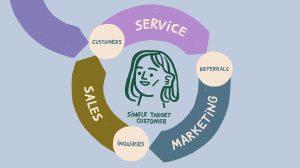Written by Daniela Furtado
The right digital marketing strategies can help interior designers and architects attract more customers online and grow their business. Here are 15 tips to help you achieve this.
For some time now, we’ve all been slowly and steadily working together to become more digital in every aspect of our lives. However, once we were hit with the pandemic, the digital transition was accelerated; nearly everyone around the world has been impacted and is working to adapt.
Business owners that didn’t before now must learn to build an online presence, like establishing a website or social media pages, for their brand as more consumers turn to online solutions.
But is just having a website or social media account enough for interior designers businesses? In short, not really. That’s just half the battle.
The design and architecture industry has a complicated history with marketing – a topic Dr. Brynne Campbell explores in her paper, Marketing Architecture in Canada: Exploring the Architecture Profession’s Understanding and Use of Marketing. This history has held the industry back from training university students in the business or providing professionals with marketing seminars at conferences towards their CEUs. And to add salt to injury, digital marketing evolves tremendously quickly.
Frankly, the industry is behind and there’s a lot to keep up with.
Here’s a list of digital marketing tips interior designers can use to up their marketing efforts.
Jump Ahead
- 15 Digital Marketing Tips for Interior Designers
- Have a Website
- Niche Down
- Pay Attention to Your Competitors
- Build a Strong Portfolio
- Invest in a Photographer for Your Portfolio
- Turn Your Portfolio Into a Case Study and Blog Posts
- Get a Google My Business (GMB) Account
- Get Testimonials and Reviews for Your GMB
- Pitch Your Projects to Design Magazines
- Invest in Google Ads
- Join Directories
- Build Strategic Partnerships
- Attend Events Your Target Customers Go To
- Speak on Podcasts or as a Guest on Blog Posts
- Have an E-Commerce?
- Final Thoughts for Interior Designers
1. Have a Website
If you don’t already have one, choose from a variety of website-building platforms like WordPress and build one.
By setting up a website, people from around the world can view and read about your work any time they choose. The best part? You get to choose what you want to show and say to describe your designs and work.
By uploading photographs, descriptions, a services page, limited time offers, products and more, you can take this opportunity to market yourself to your target audience and show them just how talented you are.
On the other hand, if you do have a website, is it up to date? Is it mobile-friendly? When a potential customer visits your website, they expect you to be on top of design in all mediums – including web, even though it’s not your medium.
Customers judge your design expertise not just based on your portfolio but also based on the design of your website, branding, outfit and office. In their minds, they would imagine that a professional designer would care about the impression they give and the way they look across all mediums.
The quality of your website can have a considerable impact on their decision to work with you. If you have money to spare, you can also hire a professional to help you set up or redesign your website.
2. Niche Down
When talking about the scope of your work, don’t just describe it as residential or commercial, be more specific. Do you work with homes or condos? Retail stores or hospitality?
By niching down and talking about your specializations, you improve your chances of being noticed by the potential customers that you are targeting.
For example, when we first started working with Sansa Interiors, an interior design company in Toronto, we helped them niche down their services from “commercial” and “residential” to “restaurant” and “full residential renovations”.
This made their services easier to understand and better for searchability on Google. You can learn more about their case study here.
3. Pay Attention to Your Competitors
Your competitors have done it before and better than you so there’s plenty that you can learn from them. What are they doing to make their brand stand out online and to attract all their leads? How is their website different from yours?
If your competitors are targeting the same keywords as you, why are they ranking higher on Google’s result pages and how can you outrank them?
The idea isn’t to copy what they’re doing but to take inspiration from them and find their gaps.
Find gaps of opportunity in finding keywords that they’re not targeting, gaps in their website design, gaps in their marketing efforts and then go back and do it better for your own interior design brand.
4. Build a Strong Portfolio
This is a must as a designer. Your portfolio is what showcases the length and depth of your skills and expertise; it represents you as an interior designer and can help you stand out among your competitors.
A strong portfolio will communicate and market your interior design brand in your absence. It can prove that you’re a professional and that you’re serious about your work.
Building a strong portfolio that shows your skill will capture the attention of your targeted audience or the kind of people you’d want to work with.
Looking for more SEO tips? We’ve got you covered – we’ve also written 13 SEO tips for interior designers.
5. Invest in a Photographer for Your Portfolio
Yes, this sounds expensive but these photos will be on your website for years to come.
So if you want to get featured in design magazines, hiring a professional photographer to capture your best work and your aesthetics will better communicate and display your talent.
Quality images that are clear can work as a powerful marketing tool to help attract your target audience.
In fact, there may be projects that will take you years to complete. So before you can put it on your site, consider using your renderings in place of professional photos.
Our client Seven Point Interiors is an example of designers that uses extremely high-quality renderings in their portfolio. This is especially common for firms that do commercial, industrial and institutional projects.
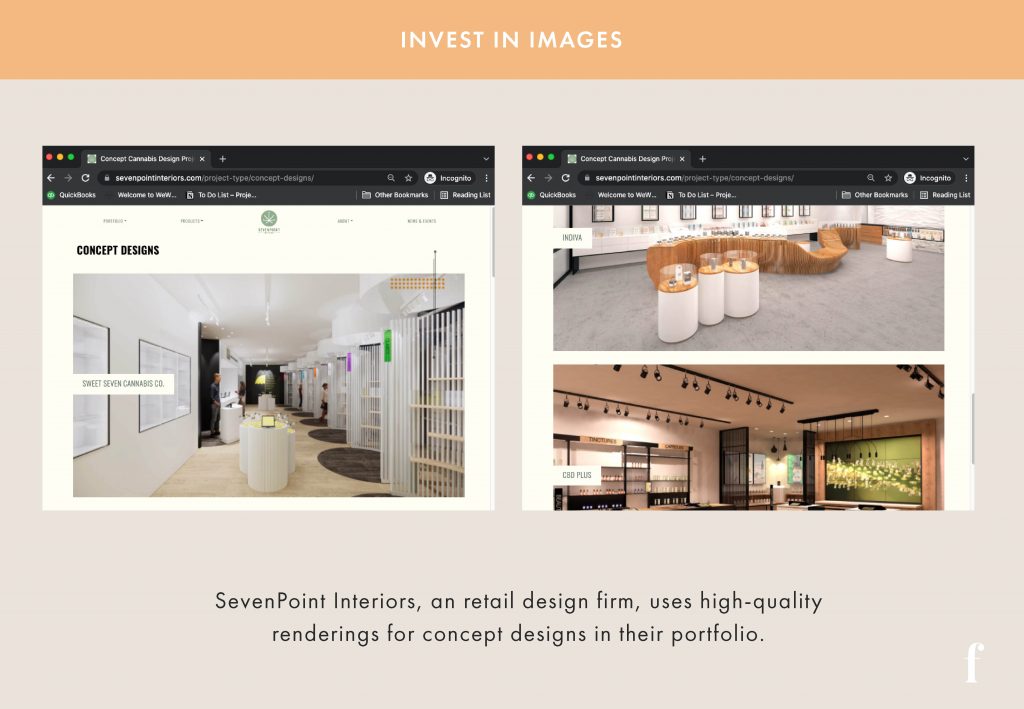
6. Turn Your Portfolio Into a Case Study and Blog Posts
Interior designers often just upload a photo gallery to their website as their portfolio. The problem with that is that the reader doesn’t know what you did. What did the space look like before? What did YOU do?
As an interior designer, people often confuse you with a decorator. When you add content to your portfolio (a.k.a tell the story or make it a case study), you can show your process and help readers understand the value of your service.
You can take it a step further and create blog posts that go into detail on a case study.
For example, you put together a case study on a home renovation for a heritage home by showing the before, during and after process. In a blog post, you can write a thought leadership piece or educational piece about renovating heritage homes then mention and link back to the case study.
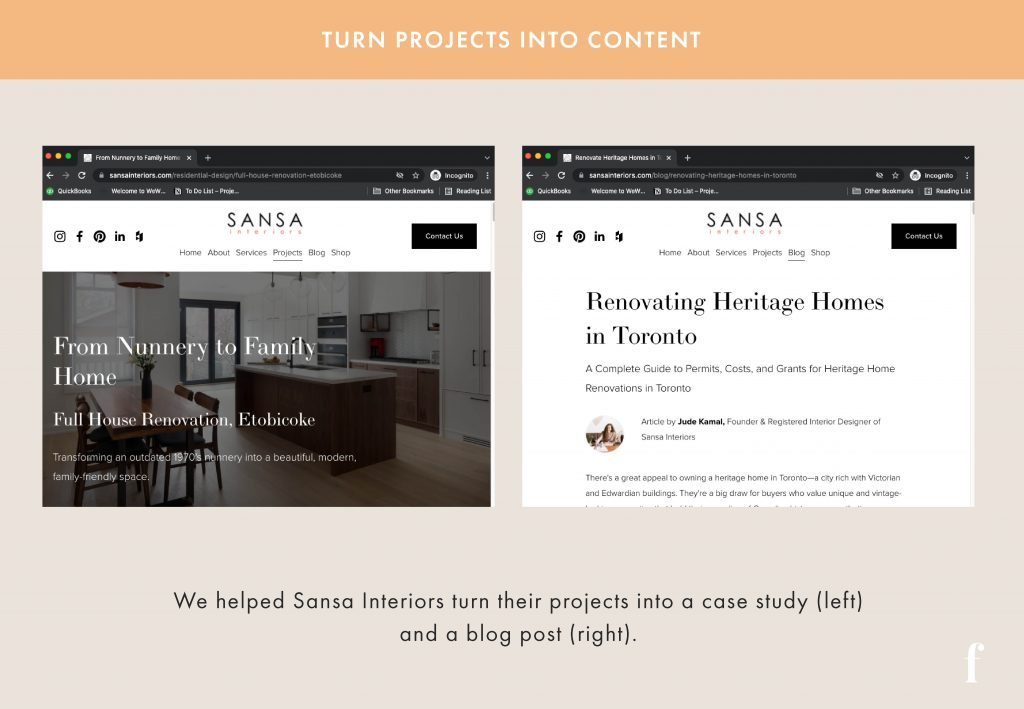
Not only does this help sell your services before customers get on a sales call, but you have content that you can turn into social media posts, PR marketing promotions and you can use keywords to get organic traffic to these blog posts too! Want to learn more about getting more traffic to your blog posts? Check out our tips here.
7. Get a Google My Business (GMB) Account
A Google My Business account is a great marketing tool for interior designers because it can help your brands discoverability and ranking on the engines search results page.
Designers often overestimate social media platforms like Instagram and the kind of marketing these platforms can do for their brand.
Yes, people will browse around and look at your social media pages but these views won’t necessarily get you as much business as search engines like Google or even Pinterest can.
Why? Because people go to Instagram to scroll and kill time. People go to Google with the intention to hire an interior designer.
Social media platforms often make great visual portfolios for interior designers. Search engines like Google and Yahoo, on the other hand, are where we go to find answers and solutions.
8. Get Testimonials and Reviews for Your GMB
When you’re just starting out, do what you can to get as many reviews and testimonials as possible. Reviews are an effective marketing strategy for interior designers. They can build your credibility and very much influence the consumers buying decisions.
Ask for a review from those that you may interact with often like your suppliers, people you gave free consultations to or from people that attended one of your free lectures. If you helped a friend, get a testimonial from them too!
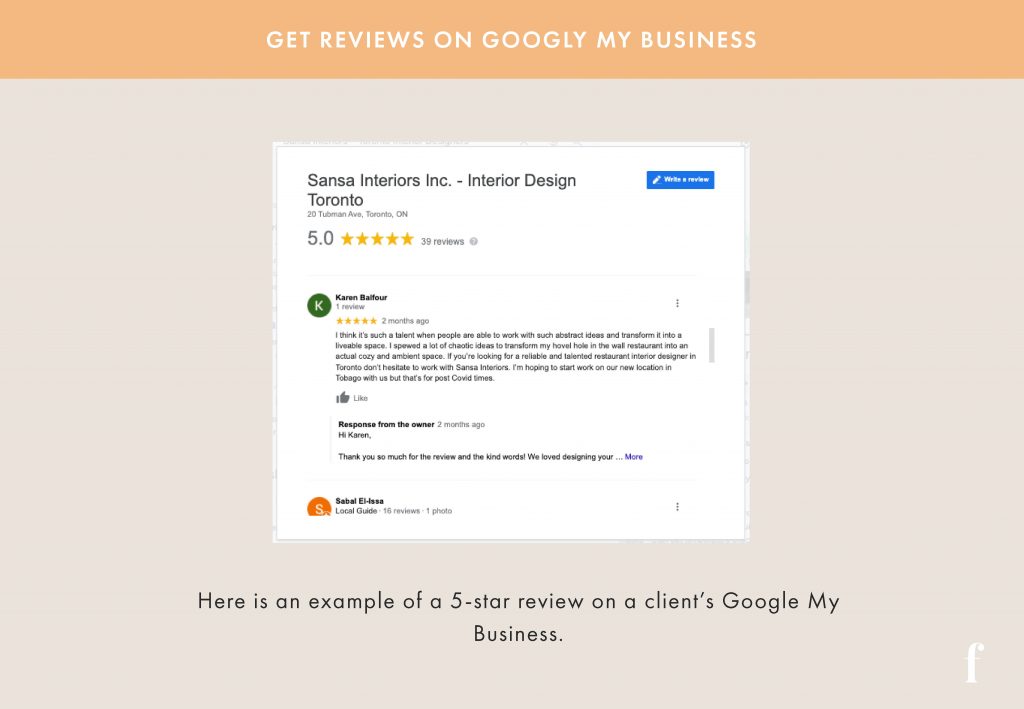
Set up a process internally to get a consistent flow of reviews. You could include review management into your sales process. This could mean sending an automated email once the project is done or the final invoice is paid, with a link and questions to help clients leave a review promptly.
9. Pitch Your Projects to Design Magazines
Getting featured in a design magazine can make a big difference for your interior design career and could be a game-changer for your business.
It can launch your interior design business to a broader audience, give you credibility and social proof, and attract new clients.
Here are our tips on how you can get your interior design business featured in a design magazine.
10. Invest in Google Ads
Google Ads, formerly known as AdWords, is an online advertising platform. You can directly pay Google and use search or display ads to promote your interior design website on Google’s platforms.
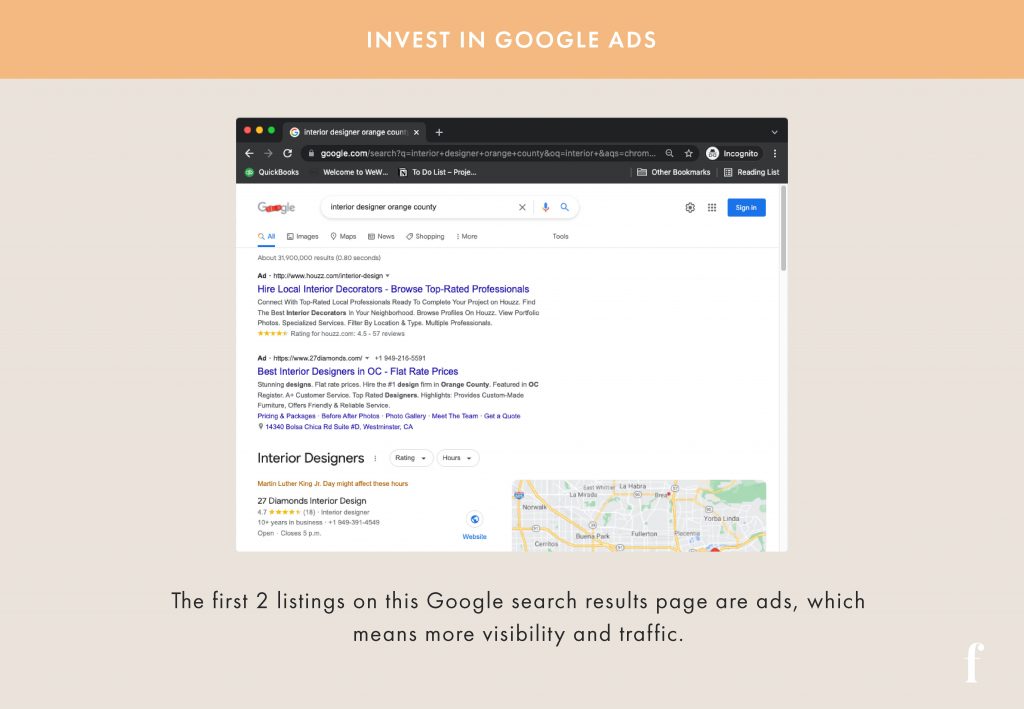
With search ads, you can bid for keywords. In other words, you can tell Google which keywords you want your website to appear for and pay for every click.
Keep in mind that interior designers can consider this marketing tip when you have decent SEO for your brand. You can learn more about how to work with Google Ads here.
11. Join Directories
List your website on general ones like Yellow Pages and also directories that are specific to designers like Houzz.
There are many benefits to listing your interior design website on a variety of online directories. Getting on online directories can bump up your SEO and discoverability on Google’s results pages and improve your online visibility.
Our clients tell us that they haven’t gotten too much tracked but it doesn’t hurt to make a profile and get a backlink. Remember to double-check that the information you submit is both accurate and up to date.
12. Build Strategic Partnerships
Throughout all your projects, you will interact with various vendors, suppliers and so on. It will greatly benefit your interior design business to make an effort to build and maintain strategic partnerships with them (a.k.a contractors or real estate agents) as they could provide you with valuable referrals.
Try to build relationships with influencers on social media that could help you get PR marketing by talking up your business on either their accounts or by spreading the word about you and your business. A good impression and relationship go a long way.
13. Attend Events Your Target Customers Go To
Depending on your niche, consider attending conferences, events and such, that focus on your interior design niche. This tip is especially great for commercial designers.
For example, If you’re an interior designer for restaurants, go to conferences for restaurants and or maybe even events that focus on the foodservice industry. Either make it a point to network or consider pitching yourself to speak at one of these events.
14. Speak on Podcasts or as a Guest on Blog Posts
Podcasts and blogs are capable of generating a great amount of traffic and can have a huge loyal fan following.
If you’re familiar with the platforms your target customers pay attention to, consider pitching your interior design business to those platforms, share your expertise and help your audience get familiar with your personality.
You can be interviewed in blog posts or be a guest speaker on an interior design specific podcast. Don’t forget to get that backlink!
Backlinks are made when another website mentions and links to yours. Backlinks are validations from community and industry and are the highest weighted ranking factor in Google’s algorithm.
15. Have an E-Commerce?
If you’re an interior designer that also sells products like furniture, fixtures or artwork as a secondary source of income, look into showcasing your work and products on Pinterest.
We wouldn’t recommend this particular marketing tip for service-only interior design businesses because it brings a lot of traffic from people that are on a budget or just looking for ideas, however, chances of conversions are typically high for furniture and home decoration.
Final Thoughts for Interior Designers
We have provided you with a long list of digital marketing tips to improve your interior design brand’s online presence and to attract more clients but, keep in mind that not all the tips can help you generate greater traffic or leads overnight.
It is up to you to be patient and to monitor the progress or impact of these marketing tips and be mindful of making adjustments where needed.
You have access to plenty of resources within the tips mentioned above to help you learn more about digital marketing and exercise each marketing tip. The effort you invest today could yield great rewards in the long term.
If you’re looking to hire a professional to help with marketing your interior design brand online, we at Findable Digital Marketing have a team of seasoned experts and we offer a range of services to help you achieve exactly that. Get in touch with us today to learn more!
Daniela Furtado
Daniela Furtado is a consultant, writer and speaker on how to make businesses easy to find online. She is the founder and CEO of Findable Digital Marketing. Off the clock, she enjoys cooking, dancing, and drawing. She is based in Toronto, Canada.
 Never Have Time to Market Yourself? Here’s Why
Never Have Time to Market Yourself? Here’s Why Why You’re Not Getting High-End Clients
Why You’re Not Getting High-End Clients Is Your Interior Design Portfolio Traffic-less?
Is Your Interior Design Portfolio Traffic-less?